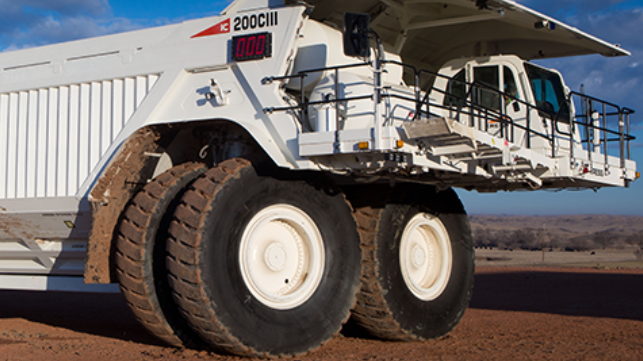Mining Equipment Could Inspire New Methods for Cargo Handling

Vehicles used at maritime ports to move containers and bulk cargo might seem to have little in common with mining trucks. However, there may actually be scope to adapt a unique mine area vehicle to port transfer operations.
Introduction
The present COVID-19 pandemic has slowed operations at several international ports and slowed economic growth in many nations. There is potential for renewed economic growth and expanded trade in the years that follow the pandemic. While the future increase in trade would require larger terminal areas at major ports, there is also the scope of developing offsite terminals located near main ports. Such development would require application of technology capable of efficiently moving containers and bulk freight between port side and offsite terminals. Semi-automated and automated railway and overhead mono-rail operations are possible at some locations.
The presence or installation of road-level railway crossings would impede freight transfer operations, leaving overhead monorail as an alternative container transfer technology. While modified conventional rubber-wheel road vehicles do move containers around port terminal areas, the technology is slow moving and has low efficiency when moving bulk freight between an offsite and a port side terminal. A newly-developed mining truck offers future potential of being adapted to port area freight transfer operations, including both container and bulk freight transfer along dedicated port area rights-of-way.
Bulk Freight
Mining trucks are bulk freight carriers and traditional mining truck designs would be impractical to operate in port terminal areas, even between offsite and port side terminals. While capable of carrying over 200 tons on two axles, traditional mining trucks would be incapable of negotiating tight turns in port terminal areas. A newly designed version is capable of negotiating tight turns, using a front wheel steering concept that is based on aircraft forward landing gear. This design offers the potential to be modified into a rubber-wheeled hopper car capable of carrying a variety of dry bulk freight.
The new design has eight tires on two axles and can turn its front wheels to the previously unheard of angle of 85 degrees. Its carrying capacity allows it to efficiently transfer agricultural bulk freight between nearby offsite silos and port side silos at locations where investing in and maintaining railway lines would be more costly. Like a railway hopper car, it loads bulk freight from directly above and dumps the bulk freight into temporary underground storage, using bottom doors installed within the wheelbase. Its size would restrict its operational area to dedicated roadways, crossing over a public road at a traffic-light controlled intersection.
Container Transfer
While the vehicle would require little or no modification to adapt it to port area bulk transfer service, it would require more extensive modification to operate in container transfer service. It would require a longer wheelbase to carry 40-foot containers lengthwise. One modified version of the truck could carry two containers side-by-side, with potential to carry three levels in height with possible scope to tow a trailer. It represents a rubber-wheeled vehicle capable of carrying up to 12 TEU.
The port side and offsite terminals would need to be located within close proximity and involve only a single traffic-light controlled roadway intersection. Unlike railway vehicles that would be restricted to tracks, a rubber-wheeled vehicle would offer much greater flexibility in terms of moving around a port area, or between nearby container terminals. There may be future scope to develop an automated battery-electric version of the vehicle with front and rear steering to improve turning capability within port terminal areas.
Conclusions
The bulk carrier truck has potential applications that go beyond the mining sector. An automated (computer driven) version of the vehicle that uses battery-electric or hybrid-electric propulsion technology could be adapted to service carrying bulk freight between port side silos and nearby offsite silos. Likewise in container transfer operations, a vehicle based on this design technology could be developed to container up to three levels of two rows of containers along port roadways, at lower cost than using railway technology.
Harry Valentine is a regular contributor to The Maritime Executive.
The opinions expressed herein are the author's and not necessarily those of The Maritime Executive.
